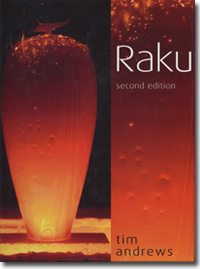Rick Foris
Contemporary Raku Ceramics
|
For years Rick was known as the master of the fickle and unpredictable copper matt glaze – he worked exclusively with the vivid colours the technique offered for almost 12 years. Eventually I felt I’d done everything I could with it and it was time to move on. I also became too particular about how I wanted the surfaces to turn out. My firing days are usually 10 to 12 hours long and it wasn’t uncommon to fire and refire my pieces all day and only get one or two acceptable pots for my troubles. The stress and anxiety weren’t worth it. Abandoning the copper matt, Rick turned to incorporating painted surfaces with the raku process. Many of the current pieces have a simple, white crackle glaze or are left unglazed and just smoked black or reduced very lightly with wet sawdust for a mottled texture. Acrylics are then applied in layers, dry-brushed over each other to build up a deeply textured, brightly coloured surface. The technique offers unlimited freedom to use colour and surface texture without risking the breakages associated with multiple raku firings. Dramatic juxtapositions of strong geometric decoration with smoked black or vivid uniform coloured surfaces give the work a fantasy filmic quality. Together with the elaborate ornamentation of three-legged trivet bases, raised platforms, steps, embellished lids and other visual hyperbole, the pieces revel in a magnificent combination of Alice in Wonderland and an imagined alien culture. Rick uses an old electric kiln mounted on a hard-brick firebox and fired with a 500,000 BTU weed burner. The lid is wire mesh panel lined with ceramic fibre with a 20cm (8in.) hole cut in the middle for a flue. He is very particular about achieving a consistent glaze surface so, to avoid hot spots in the kiln, he covers the kiln shelf with broken bits of soft brick which act as a heat baffle to diffuse the flame. Usually only one or two pieces are fired in each load. At glaze melt (around 1000 C/1832 F), the kiln is turned off and allowed to cool to 650 C (1202 F). The pot is removed and placed upside-down in the reduction bin; this keeps it hotter for a longer period and helps to develop a darker crackle pattern. The piece is covered completely with hardwood sawdust. Rick still experiments with glazes each time he fires. He keeps a detailed notebook to document his tests: firing temperature, kiln atmosphere (sometimes pots are reduced in the kiln as they are heated), post-firing reduction materials, the size and type of piece, and weather conditions, are all carefully recorded. I like to use extruded tubes for tests rather than
tiles, and they give a more accurate picture of what the glaze will
look like on a 3-dimensional pot, how the glaze flows, etc. Most
of the glazes never go much further than the test stage but I save
all my notes and the tubes for further reference. Somewhere down
the line that ugly, crusty glaze might be just what I’m looking
for." |
189 County Road ZZ North - Amherst Junction, Wisconsin 54407 - 715.824.2809
 "Rick
Foris makes fantastic and eccentric sculptural pieces. Many are
constructed using complicated assemblages of disparate components.
Separately, the elements seem familiar: bases, handles, lids and
spouts which betray his origins as a functional potter. Some draw
on architectural resonances from Aztec and Mayan culture, and shapes
reminiscent of Oriental tea vessels, ceremonial temple ware, gold
Russian minarets and even bits from an engineer’s scrap-yard.
The sum of each sculpture, however, is much more than its parts
and ultimately the pieces defy attempts to impose a provenance.
Instead they offer themselves as stunning individual objects with
more than a touch of Hollywood about them.
"Rick
Foris makes fantastic and eccentric sculptural pieces. Many are
constructed using complicated assemblages of disparate components.
Separately, the elements seem familiar: bases, handles, lids and
spouts which betray his origins as a functional potter. Some draw
on architectural resonances from Aztec and Mayan culture, and shapes
reminiscent of Oriental tea vessels, ceremonial temple ware, gold
Russian minarets and even bits from an engineer’s scrap-yard.
The sum of each sculpture, however, is much more than its parts
and ultimately the pieces defy attempts to impose a provenance.
Instead they offer themselves as stunning individual objects with
more than a touch of Hollywood about them.